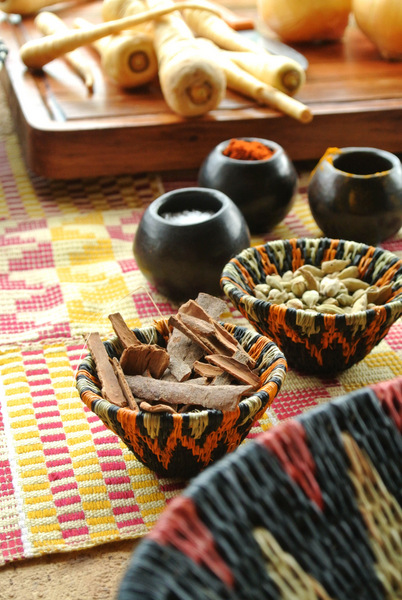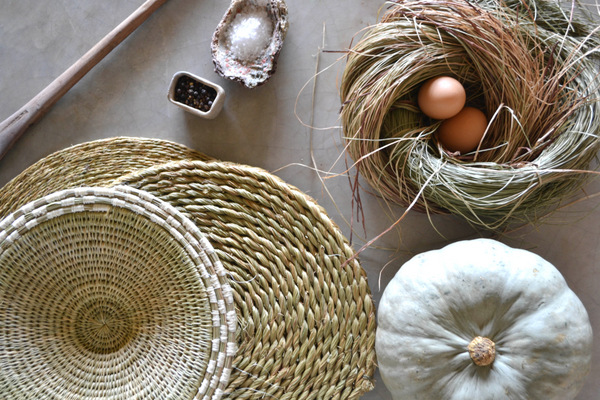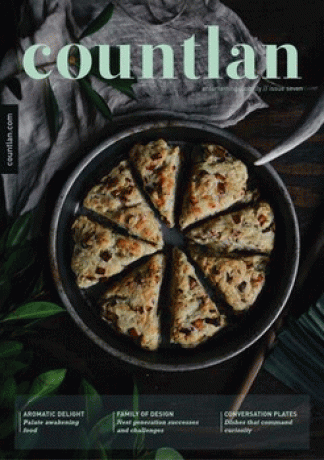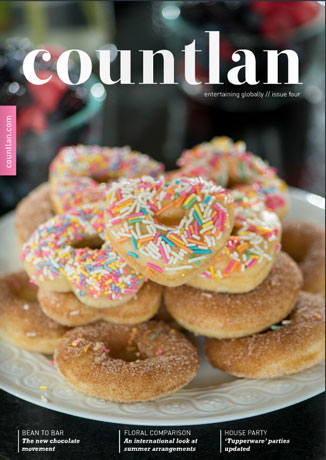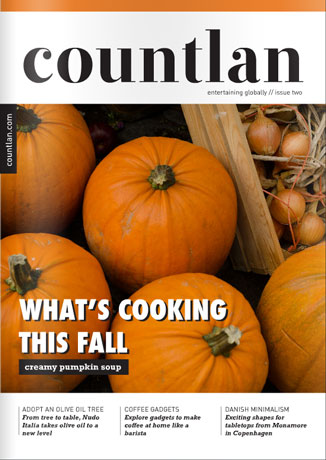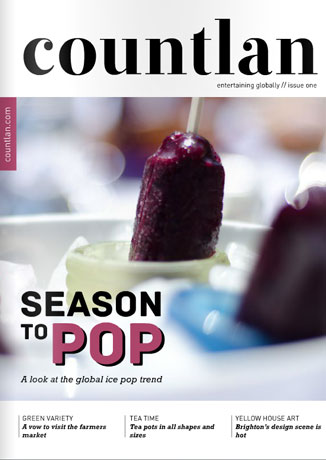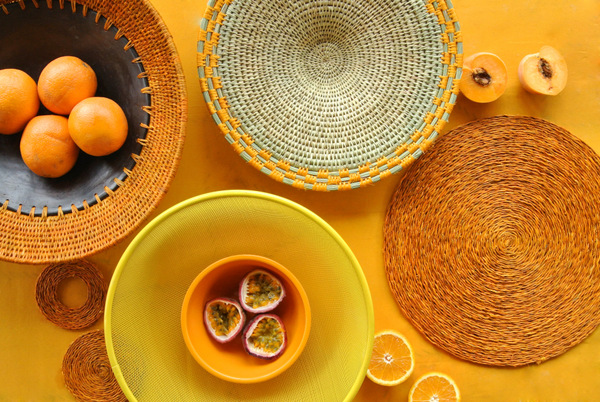
Swaziland Gone Rural’s Arc Bowl
We ventured far and wide to assemble a “Made In” collection worthy of your table. From our eclectic mix of Made-In items introduced in Issue 04, we share the stories behind each designer, inspiration for the product and a look at the materials, design process and cultural tie to the country in which the item was produced. First up, we speak with the marketing manager of an innovative design company based in Swaziland, the landlocked country in southern Africa where indigenous lutindzi grass grows- a sustainable material that is excellent for weaving.
INTERVIEW: Georgina-Kate Adams, Marketing Manager for Gone Rural and non-profit- Gone Rural boMake
01: Who are you/what is your involvement in Gone Rural?
Hi! My name is Georgina-Kate Adams and I am the marketing and communications manager for Gone Rural and our non-profit, Gone Rural boMake. I moved to Swaziland from the south of England at the beginning of January.
02: How did Gone Rural get started?
Gone Rural started organically in the 1970s and was officially registered in 1992. Our founder, the late Jenny Thorne, co-founded a series of shops across Swaziland which sold local crafts. Through these, she saw an opportunity to use handcraft as a means to empower the women of Swaziland. Until recently, Swazi women had very few rights and were forced to rely on men to support them – not even allowed to own a piece of land in their own name. But up in the mountains, where the indigenous lutindzi grass grows wild, Jenny saw women weaving and saw an opportunity to help them use these skills to secure a sustainable, independent income with which to support themselves and their family.
03 Where are the products made and by whom?
Gone Rural today works with more than 750 artisans across Swaziland – from young women to gogos (grandmothers) and often with three generations of women from one family. One of our founding principles is that our women should be able to secure a sustainable income alongside fulfilling their traditional duties, so all our women work from their own homes. However, many of our 13 groups often like to meet under a tree to work together and we strongly support this kind of peer education. We have supported the development of community centres in several regions and are fundraising to build more. Our Mahlanya group also come to work at our workshop every Tuesday, where they can collaborate with our in-house sample makers and design team.
In addition, we employ a small number of local male artisans, who make the aluminium, bone and wire elements of our designs. We also collaborate with a selection of local businesses, such as Swazi Ceramics, and aim to be as innovative as possible with the resources we have available.
04 How would you describe the design aesthetic of the GR homeware line?
Whenever we approach a new design, our focus is always preserving the past, understanding the present and pioneering the future. There is a very soulful connection between the work that goes into a basket and the final design. We are inspired by the women themselves and the environment in which the pieces are crafted. Our aim is always to preserve that and to work resourcefully with the local, sustainable fibres available to us, and then to see how far we can innovate with those limited materials.
We spend a lot of time experimenting with how we can create contemporary shapes, which are functional as well as beautiful, and we are forever challenging ourselves to be better than we were yesterday. One way we do this is through collaboration and design partnerships. We are also very lucky to have a creative director who was educated at London’s Central Saint Martins College of Art and Design and is a great innovator, Philippa Thorne.
In addition to our mainline GR Collection, we recently launched a signature collection, The Song of the Weaver, which uses design as a canvas to story-tell the memoirs of the Gone Rural women. The debut collection, which we launched with an exhibition in London, was inspired by three generations of our weavers from one family. We asked each to craft a large-scale Biography Basket telling their life stories and from these designed a range of stunning retail collections.
My favourite piece is taken from the Backbone series of The Siphiwe Collection. Siphiwe is the backbone of her family so the Arc Bowl uses lutindzi grass, upcycled textile waste and discs of cow bone to replicate the shape of a rib cage. The first time I saw it, it took my breathe away.
05 Can you share a bit about the materials used in GR items?
We work by the triple bottom line of People, Planet, Profit, so when it comes to sourcing materials, we don’t think about what we’d like to use, but about what we have, and how we can innovate with that. We are not interested in trashing the earth just to add a pretty plastic trim to a product. It’s got to be authentic. Our signature material is the lutindzi grass indigenous to the Swazi mountains, and that is unique to Gone Rural. It is sustainably-harvested (cut, not pulled out of the ground) by our women. We then use eco-dyes to colour it, before laying it out to dry naturally in the sun. We also work with other local fibres, such as sisal, reeds and clay. Our upcycled pieces, such as the Fluoro vases, combine off-cuts from nearby textile factories with recycled leather scraps and sweet wrappers.
06 How often are new products released in the line?
We are constantly innovating at Gone Rural HQ, but only the best pieces make the cut! We will be officially releasing this year’s new pieces into The GR Collection and our African Collection in the summer, as well as unveiling our debut accessories line, Go Rural. However, in reality, we are always releasing new pieces, as we are constantly creating custom pieces for our customers. The British homeware chain John Lewis, for example, just took a diffusion piece inspired by The Song of the Weaver’s Bonakele Collection. It combines our Block Weave design with a clay base and is unique to their stores. We will be releasing our second signature collection in 2014.
07 Do you have any GR pieces in your home?
Both at my family home in England and at my flat in Swaziland, Gone Rural placemats are a must-have for every meal. They’re really long-lasting, easy-to-clean and heat resistant – and always win a compliment from party guests! I also have our lime table runner in my kitchen and a woven candle holder for tee lights. In my bedroom, I use an assortment of baskets to store my belts and jewelry and I have a very long wish-list of pieces I’d like to add to my collection! Top of it is a Gone Rural lampshade and one of every piece from The Song of the Weaver. They’re works of art!
08 Do you entertain at home?
I love entertaining, although I wouldn’t say my cooking is much above amateur! I’m a big fan of barbecues and quiet evenings in with close friends, eating hearty food and drinking good wine. I am increasingly getting into cooking Swazi-style, such as pap, pumpkin and chicken in oxtail soup. And I love to add a little exotic twist to my parties. For me, it’s all about presentation, so Gone Rural pieces are a great way to make an amateur dish look first class!

Photo Source: Gone Rural Swaziland
MADE IN: Swaziland // Gone Rural- Arc Bowl
Gone Rural, a Swaziland based homeware and accessory company that started organically in the 1970s as a series of shops created by the late founder, Jenny Thorne. In the mountains, where the indigenous lutindzi grass grows wild, Jenny saw an opportunity to help women use their grass weaving skills to secure a sustainable, independent income with which to support themselves and their family.
Design Process:
Whenever we approach a new design, our focus is always on preserving the past, understanding the present and pioneering the future. There is a very soulful connection between the work that goes into a basket and the final design. We are inspired by the women themselves and the environment in which the pieces are crafted. Our aim is always to preserve that and to work resourcefully with the local, sustainable fibers available to us, and then to see how far we can innovate with those limited materials.
We spend a lot of time experimenting with how we can create contemporary shapes, which are functional as well as beautiful, and we are forever challenging ourselves to be better than we were yesterday. One way we do this is through collaboration and design partnerships. We are also very lucky to have a creative director who was educated at London’s Central Saint Martins College of Art and Design and is a great innovator, Philippa Thorne.
Materials:
Our signature material is the lutindzi grass, which is indigenous to the Swazi mountains and unique to Gone Rural. It is sustainably-harvested (cut, not pulled out of the ground) by our women. We then use eco-dyes to colour it, before laying it out to dry naturally in the sun. We also work with other local fibres, such as sisal, reeds and clay. Our upcycled pieces, such as the Fluoro vases, combine off-cuts from nearby textile factories with recycled leather scraps and sweet wrappers.
Arc Bowl (In Countlan Issue 04):
The Arc Bowl is from the Backbone series of The Siphiwe Collection. The Arc Bowl uses lutindzi grass, upcycled textile waste and discs of cow bone to replicate the shape of a rib cage.

